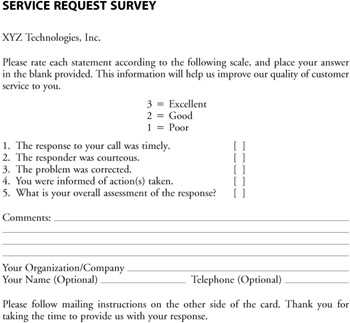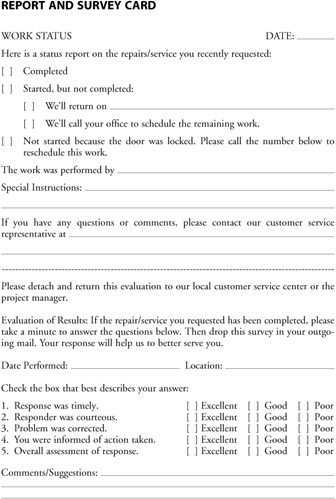Develop Measurement Tools for Assessing the Customer Service Program
|
When the first three elements for a good customer service program are in place, the actual design and development of measurement tools can begin. The four most commonly used survey response measurement tools are listed in Exhibit 12-4.
Exhibit 12-4: Survey response measurement tools.
| Measurement Tool | Advantages | Disadvantages |
|---|---|---|
| Written survey |
|
|
| Telephone survey |
|
|
| Face-to-face meetings |
|
|
| Internet Web site survey |
|
|
Written Surveys
Two types of written surveys are utilized by effective customer-oriented companies. The first, shown in Exhibit 12-5, is a short scorecard designed to get instantaneous information about a service action response. The second, shown in Exhibit 12-6, is a longer survey designed to provide the customer with information, as well as to obtain in-depth information about the company's customer satisfaction and job performance.
Exhibit 12-5: Sample customer scorecard.

Exhibit 12-6: Sample report and survey card.

A written survey is the most common measurement tool. Although they are good tools, studies show that on average only 50 percent to 60 percent of written surveys are answered, compared with 70 percent to 80 percent of telephone surveys. The problem with written surveys is that they are hard to design. They should be constructed so that the customer can quickly fill a survey out and still provide useful information.
Some key questions to ask in a survey are shown in Exhibit 12-7. It is important to include one or two open-ended questions to allow the customer to expand or clarify a concern, if she is inclined to do so. The goal in survey tool design is to provide a rigorous instrument that is user-friendly and evokes honest and candid responses.
Exhibit 12-7: Keys to effective survey question design.
| Survey Question Design | Question Examples |
|---|---|
| Start with a question that focuses on the critical issues. | What are the most important features of our service (product)? |
| Ask the customer to list priorities; stay away from numbers. | What actions do you expect when you report a problem? |
| Probe for annoyances that have not yet become full-blown problems. | What else could have we have done to improve the service rendered? |
| Try to avoid questions with obvious answers; instead, key on discriminators. | How important is fast response compared with disruption in the workplace? How important is price compared to service action completion? |
Telephone Surveys
Telephone surveys can be expensive but significantly more effective than written surveys. When a company is dependent upon contracts for its livelihood, as opposed to, say, a retail store, telephone surveys are 100 percent responsive. That is, contract officers and project officers are always willing to talk about the contract, and most of them appreciate corporate involvement. That does not mean that all customer representatives are completely candid. Eliciting usable information still requires excellent interpersonal skills and knowledge about how to ask the right questions. But the opportunities for clarification and probing are significantly greater over the telephone and provide the added bonus of establishing lasting relationships, if conducted effectively.
The Face-to-Face Meeting
The most effective customer service tool is a face-to-face meeting because it provides an opportunity to probe deeper than written surveys, and you can assess the customer's body language. In addition, and perhaps more important, it provides an opportunity to build the trust that leads to long-term relationships.
The most successful customer-oriented organizations have senior management teams routinely visit their customers. The most effective visits are informal and designed to solicit off-the-record customer information about the company's performance. The customer reacts positively to senior management visits because they demonstrate a company's commitment and that senior management listens to customer complaints.
Internet Web Site Surveys
Many companies are designing Web pages and making themselves available electronically. Even though the Web site survey is not used as much as other formats, it is a valuable measurement tool because of the feedback it elicits that wouldn't be available any other way. The anonymity of the Web page makes it more appealing to some people. It also opens the company to comment from a wider audience, namely users as well as direct customers. At this time, unfortunately, response to Web site surveys is low. However, it is bound to become a more popular response format as Web page design improves and we learn more about how to solicit feedback.
|
EAN: 2147483647
Pages: 129